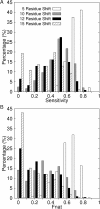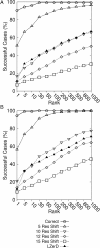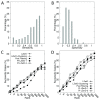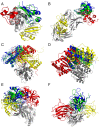Protein docking prediction using predicted protein-protein interface
- PMID: 22233443
- PMCID: PMC3287255
- DOI: 10.1186/1471-2105-13-7
Protein docking prediction using predicted protein-protein interface
Abstract
Background: Many important cellular processes are carried out by protein complexes. To provide physical pictures of interacting proteins, many computational protein-protein prediction methods have been developed in the past. However, it is still difficult to identify the correct docking complex structure within top ranks among alternative conformations.
Results: We present a novel protein docking algorithm that utilizes imperfect protein-protein binding interface prediction for guiding protein docking. Since the accuracy of protein binding site prediction varies depending on cases, the challenge is to develop a method which does not deteriorate but improves docking results by using a binding site prediction which may not be 100% accurate. The algorithm, named PI-LZerD (using Predicted Interface with Local 3D Zernike descriptor-based Docking algorithm), is based on a pair wise protein docking prediction algorithm, LZerD, which we have developed earlier. PI-LZerD starts from performing docking prediction using the provided protein-protein binding interface prediction as constraints, which is followed by the second round of docking with updated docking interface information to further improve docking conformation. Benchmark results on bound and unbound cases show that PI-LZerD consistently improves the docking prediction accuracy as compared with docking without using binding site prediction or using the binding site prediction as post-filtering.
Conclusion: We have developed PI-LZerD, a pairwise docking algorithm, which uses imperfect protein-protein binding interface prediction to improve docking accuracy. PI-LZerD consistently showed better prediction accuracy over alternative methods in the series of benchmark experiments including docking using actual docking interface site predictions as well as unbound docking cases.
Figures










Similar articles
-
LZerD webserver for pairwise and multiple protein-protein docking.Nucleic Acids Res. 2021 Jul 2;49(W1):W359-W365. doi: 10.1093/nar/gkab336. Nucleic Acids Res. 2021. PMID: 33963854 Free PMC article.
-
Human and server docking prediction for CAPRI round 30-35 using LZerD with combined scoring functions.Proteins. 2017 Mar;85(3):513-527. doi: 10.1002/prot.25165. Epub 2016 Oct 14. Proteins. 2017. PMID: 27654025 Free PMC article.
-
Pairwise and multimeric protein-protein docking using the LZerD program suite.Methods Mol Biol. 2014;1137:209-34. doi: 10.1007/978-1-4939-0366-5_15. Methods Mol Biol. 2014. PMID: 24573484
-
LZerD Protein-Protein Docking Webserver Enhanced With de novo Structure Prediction.Front Mol Biosci. 2021 Aug 12;8:724947. doi: 10.3389/fmolb.2021.724947. eCollection 2021. Front Mol Biosci. 2021. PMID: 34466411 Free PMC article. Review.
-
Protein-protein docking tested in blind predictions: the CAPRI experiment.Mol Biosyst. 2010 Dec;6(12):2351-62. doi: 10.1039/c005060c. Epub 2010 Aug 19. Mol Biosyst. 2010. PMID: 20725658 Review.
Cited by
-
LZerD webserver for pairwise and multiple protein-protein docking.Nucleic Acids Res. 2021 Jul 2;49(W1):W359-W365. doi: 10.1093/nar/gkab336. Nucleic Acids Res. 2021. PMID: 33963854 Free PMC article.
-
VORFFIP-driven dock: V-D2OCK, a fast and accurate protein docking strategy.PLoS One. 2015 Mar 12;10(3):e0118107. doi: 10.1371/journal.pone.0118107. eCollection 2015. PLoS One. 2015. PMID: 25763838 Free PMC article.
-
Docking studies and network analyses reveal capacity of compounds from Kandelia rheedii to strengthen cellular immunity by interacting with host proteins during tuberculosis infection.Bioinformation. 2012;8(21):1012-20. doi: 10.6026/97320630081012. Epub 2012 Oct 31. Bioinformation. 2012. PMID: 23275699 Free PMC article.
-
Assessment of protein side-chain conformation prediction methods in different residue environments.Proteins. 2014 Sep;82(9):1971-84. doi: 10.1002/prot.24552. Epub 2014 Mar 31. Proteins. 2014. PMID: 24619909 Free PMC article.
-
Understanding the fabric of protein crystals: computational classification of biological interfaces and crystal contacts.Bioinformatics. 2016 Feb 15;32(4):481-9. doi: 10.1093/bioinformatics/btv622. Epub 2015 Oct 27. Bioinformatics. 2016. PMID: 26508758 Free PMC article. Review.
References
-
- Giot L, Bader JS, Brouwer C, Chaudhuri A, Kuang B, Li Y, Hao YL, Ooi CE, Godwin B, Vitols E, Vijayadamodar G, Pochart P, Machineni H, Welsh M, Kong Y, Zerhusen B, Malcolm R, Varrone Z, Collis A, Minto M, Burgess S, McDaniel L, Stimpson E, Spriggs F, Williams J, Neurath K, Ioime N, Agee M, Voss E, Furtak K, Renzulli R, Aanensen N, Carrolla S, Bickelhaupt E, Lazovatsky Y, DaSilva A, Zhong J, Stanyon CA, Finley RL, White KP, Braverman M, Jarvie T, Gold S, Leach M, Knight J, Shimkets RA, McKenna MP, Chant J, Rothberg JM. A protein interaction map of Drosophila melanogaster. Science. 2003;302:1727–1736. doi: 10.1126/science.1090289. - DOI - PubMed
-
- Uetz P, Giot L, Cagney G, Mansfield TA, Judson RS, Knight JR, Lockshon D, Narayan V, Srinivasan M, Pochart P, Qureshi-Emili A, Li Y, Godwin B, Conover D, Kalbfleisch T, Vijayadamodar G, Yang M, Johnston M, Fields S, Rothberg JM. A comprehensive analysis of protein-protein interactions in Saccharomyces cerevisiae. Nature. 2000;403:623–627. doi: 10.1038/35001009. - DOI - PubMed
Publication types
MeSH terms
Substances
Grants and funding
LinkOut - more resources
Full Text Sources
Research Materials
Miscellaneous

